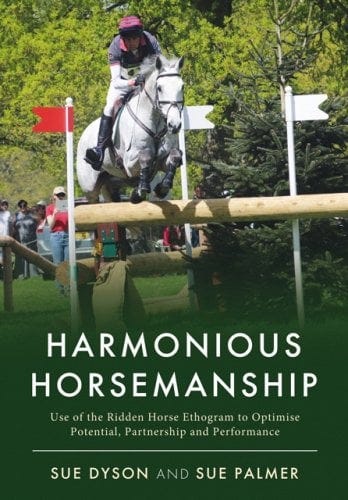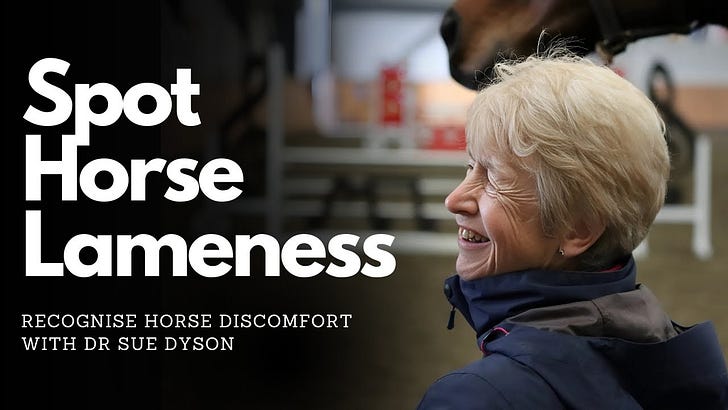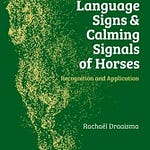"The apparently 'sound' horse is 'naughty', 'lazy', 'difficult', 'explosive', 'spooky', 'nappy', and more. These labels are wrong," declares equine veterinary specialist Dr Sue Dyson in her groundbreaking book Harmonious Horsemanship. During our interview with Dr Dyson on Curious Equestrian, she revealed how these seemingly behavioural issues are actually manifestations of pain and how a simple 24-point checklist can transform your relationship with your horse.
As an amateur rider and horse owner myself, I wish I'd had this information years ago. Here’s a systematic approach that finally makes horse welfare assessment accessible to everyone, not just professionals with that seemingly "special eye."
"anybody can learn this. Anybody, as long as you put your mind to it and you watch carefully and think about what you're seeing.
Who Desperately Needs This Book (And Who's Wasting Their Time)
Perfect For:
Amateur riders like myself who've felt intimidated by the "professional eye" for spotting problems
Horse owners whose "difficult" horses have been labelled lazy, naughty, or spooky
Riders struggling with horses that won't go forward, constantly swish their tails, or seem unresponsive
Anyone who's been told "that's just how this horse is" at their riding school
Owners seeking concrete tools to assess their horse's comfort without relying on others' expertise
Those who want to move beyond guesswork and develop genuine observational skills
Skip This If:
You believe horses displaying resistance are simply being disobedient
You're not prepared to question long-held equestrian traditions
You want quick fixes rather than systematic assessment approaches
You're comfortable always deferring to others' judgement about your horse's wellbeing
As someone who's spent years feeling like everyone around me possessed some magical ability to spot issues in horses, this book was a revelation. Dr Dyson made it clear in our interview that "anybody can learn this. Anybody, as long as you put your mind to it and you watch carefully and think about what you're seeing."
It's methodical, learnable, and removes the intimidation factor that keeps many of us relying on others' assessments.
What Makes This Book a Game-Changer
According to the publisher's description, Harmonious Horsemanship teaches readers "how to use a checklist of 24 behaviours to check for musculoskeletal pain in ridden horses" through "a gripping mix of research studies, contributions from industry experts, and real-life case studies."
During the conversation, Dr Dyson shared compelling evidence: "We've demonstrated that if you take a horse demonstrating these behaviors and you remove their pain by the use of nerve blocks...those behaviors immediately reduce in number. So the horse may be showing nine out of the 24 behaviors, and it immediately goes down to two or three out of 24."
The Ridden Horse Pain Ethogram (RHpE) transforms what feels like mystical professional intuition into concrete, observable criteria. Each behaviour is clearly defined with specific parameters; such as "the horse's head being behind a vertical position for 10 seconds or more, for 10 degrees or more" or "the speed being too hurried, which is defined as more than 40 steps per 15 seconds."
As an amateur, what struck me most powerfully was Dr Dyson's systematic observation method: positioning yourself in arena corners to see horses from behind, from the side, and approaching, ensuring you can assess all angles. It's methodical, learnable, and removes the intimidation factor that keeps many of us relying on others' assessments.
The Veterinary Specialist Behind the Methodology
Dr Sue Dyson, a renowned equine veterinary specialist with decades of experience in equine orthopaedics and sports medicine, has dedicated her career to understanding pain in horses. When Anna Louise spoke to Dr Dyson for Curious Equestrian, her passion for democratising horse welfare assessment was immediately evident. Working alongside Sue Palmer, they've created a systematic approach that challenges the equestrian establishment's acceptance of problematic behaviours as "normal."
Dr Dyson's motivation stems from a simple but powerful principle: "Only by first recognising pain can we then address it through accurate assessment, diagnosis, and treatment." Her extensive research has provided the scientific foundation that proves these behaviours aren't habitual quirks but pain responses; something many amateur horse owners have long suspected but lacked the confidence to assert.
Why This Book Transforms Horse-Human Partnerships
Harmonious Horsemanship influences practice in five crucial ways:
Recognition Over Labelling: Instead of dismissing a horse as "girthy" or "lazy," readers learn to identify specific pain indicators (such as repeated head tilting or moving on three tracks instead of two)
Systematic Assessment: The 24-point checklist provides objective criteria, removing guesswork and the need to rely on others' supposedly superior observational skills
Context-Dependent Understanding: The book explains how horses may appear comfortable when hacking but show multiple pain signs when asked to perform demanding movements in an arena
Evidence-Based Intervention: Case studies demonstrate how addressing underlying pain issues transforms both horse performance and rider safety
Professional Communication: Amateur owners gain the vocabulary and knowledge to communicate effectively with veterinarians and other professionals about their concerns
As the publisher notes, this approach leads to "greater potential, a deeper partnership, and improved performance" by addressing root causes rather than symptoms.
If you practice, you'll get better at doing it...once you've seen it and appreciated it, then it's relatively easy.
The Amateur's Perspective: Why This Changes Everything
I can't help but reflect on my own experiences and how often have I felt that others possessed some innate ability to read horses that I simply lacked?
The truth Dr Dyson revealed is liberating: it's not magic, and it's not an innate gift. It's systematic observation using defined criteria. As she told us, "If you practice, you'll get better at doing it...once you've seen it and appreciated it, then it's relatively easy." The book includes extensive photographic examples showing normal versus abnormal presentations, helping develop that crucial recognition of what healthy movement and behaviour actually look like.
For amateur owners, this book represents empowerment. Instead of constantly seeking validation from professionals about whether our concerns are "real," we can develop our own competency in welfare assessment. We can check our horses regularly and truly know what to look for, rather than hoping we'll somehow intuitively recognise problems.
What Readers Are Saying
"I think if every horse could come with this book strapped to their side at birth, a lot of horses would have a very different and better quality of life" - Miss L., verified purchaser
"Probably the most valuable book I've ever bought. As a leisure rider just trying to develop a better understanding of my equine friends there is no doubt that the information in this book will help me see and hear my horses" - JB, verified purchaser
"My wife is an IH Trainer and she loved the book finding it very useful" - Amazon customer, verified purchaser
*Amazon reviews
Beyond the Book
Dr Dyson's work extends far beyond this publication. Her research continues to challenge traditional equestrian practices and contributes to the growing body of evidence supporting horse welfare reforms. The RHpE has been adopted by organisations worldwide and is becoming a standard tool for welfare assessment.
Sue Palmer brings decades of practical experience, helping bridge the gap between scientific research and real-world application. Together, they're building a movement that prioritises horse welfare while maintaining the partnership that makes equestrian sport meaningful.
Their work addresses what they describe as the equestrian world's "social licence to operate," acknowledging that public scrutiny of horse sports demands higher welfare standards.
Get Your Copy Today
Transform your understanding of your horse's behaviour and potentially transform your partnership. Harmonious Horsemanship is available through our Bookshop.org collection, supporting independent bookstores while advancing horse welfare.
When you purchase through this link, you're not just buying a book—you're supporting the Curious Equestrian community and independent bookstores.
Discover More
Watch our full interview with Dr Sue Dyson
Horse Lameness: A Revolutionary Approach to Detecting Pain in Horses
Have you turned to your fellow horse owners in the yard and uttered, "Does my horse look right?" or "Does my horse look lame"? I certainly have or had others say things like, "He looks a bit footy," I nod along, not wanting to admit that I don't know the subtle signs of lameness. Well, no more. Dr Sue Dyson is changing all that.
Explore other essential titles in our Curious Equestrian Collection, each featuring authors we've interviewed and whose work is transforming how we understand and work with horses.






